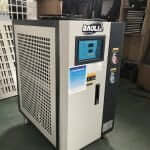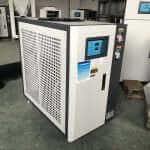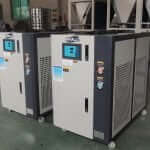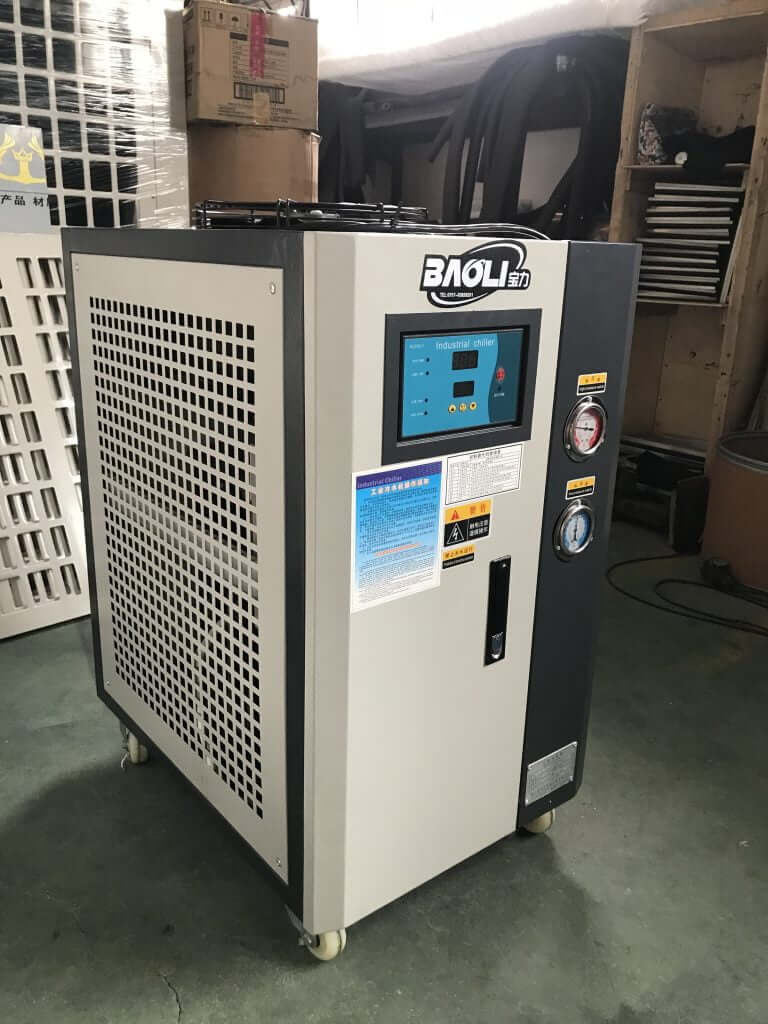Giới thiệu: Máy làm lạnh bể cá là gì?
Aquariums are not just a beautiful addition to our living spaces; they are miniature ecosystems that require careful maintenance to ensure the health and well-being of the aquatic life within. One of the crucial elements in maintaining a stable and suitable aquatic environment is the proper temperature control. This is where aquarium chillers come into play. An aquarium chiller is a device designed to lower the water temperature in the tank when it rises above the desired level, mimicking the natural conditions that many aquatic species need to thrive. Whether you have a saltwater reef tank with delicate corals and fish or a freshwater aquarium with temperature-sensitive species, choosing the right chiller is essential to prevent stress, disease, and even death among your aquatic inhabitants.
Các yếu tố cần xem xét khi lựa chọn
-
Kích thước và dung tích bể
Kích thước bể cá của bạn là yếu tố chính quyết định công suất làm lạnh phù hợp. Một bể lớn hơn sẽ cần một máy làm lạnh mạnh hơn để làm mát hiệu quả lượng nước lớn hơn. Theo nguyên tắc chung, bạn nên tính thể tích bể theo gallon hoặc lít. Ví dụ, một số 20 nhỏ – bể chứa gallon sẽ có các yêu cầu làm mát khác nhau so với bể 100 – gallon tank. A chiller that is too small for the tank will struggle to maintain the desired temperature, leading to fluctuations that can be harmful to the fish and plants. On the other hand, a chiller that is too large will not only be a waste of money but may also cause excessive cooling, which can also have negative impacts. It’s important to find a chiller that is rated for the appropriate tank size to ensure efficient and accurate temperature control.
-
Water Temperature Requirements
Different aquatic species have specific temperature preferences. Some fish and corals thrive in cooler waters, while others prefer a slightly warmer environment. For instance, tropical fish usually do well in temperatures between 75°F and 82°F, while certain marine invertebrates like some species of corals may require a more precise temperature range around 78°F. It’s crucial to research the temperature needs of the specific organisms in your aquarium. If you have a diverse community of aquatic life, you may need to find a compromise temperature that suits most of them. The chiller you choose should be able to maintain the desired temperature range accurately. Some advanced chillers even come with programmable temperature settings, allowing you to customize the temperature according to the needs of your aquarium inhabitants.
Hiệu quả năng lượng là một yếu tố quan trọng cần cân nhắc khi lựa chọn máy làm lạnh bể cá. Một máy làm lạnh tiết kiệm năng lượng hơn sẽ không chỉ giúp bạn tiết kiệm tiền điện về lâu dài mà còn thân thiện với môi trường hơn. Hãy tìm những thiết bị làm lạnh có xếp hạng hiệu quả năng lượng cao. Chúng thường sử dụng các công nghệ và linh kiện tiên tiến để giảm thiểu mức tiêu thụ điện năng trong khi vẫn mang lại khả năng làm mát hiệu quả. Một số tính năng cần tìm bao gồm máy nén hiệu quả, cách nhiệt tốt và hệ thống kiểm soát nhiệt độ thông minh giúp điều chỉnh công suất làm mát dựa trên nhu cầu nhiệt độ thực tế. Đầu tư vào một máy làm lạnh tiết kiệm năng lượng ban đầu có thể tốn kém hơn một chút, nhưng mức tiết kiệm theo thời gian có thể rất đáng kể, đặc biệt đối với các bể cá lớn hơn cần làm mát liên tục.
The noise level of the chiller can have a significant impact on both the aquatic life and the surrounding environment. A noisy chiller can cause stress to the fish, which may affect their behavior and health. In a home setting, a loud chiller can also be a nuisance to the occupants. When choosing a chiller, look for models that are designed to operate quietly. Some manufacturers use sound-dampening materials and advanced motor technologies to reduce noise. It’s a good idea to read reviews and ask for recommendations from other aquarium owners about the noise levels of different chillers. A quiet chiller will provide a more peaceful and relaxing environment for your aquarium and your home.
Choosing a reputable brand with reliable products is essential when it comes to aquarium chillers. A well-known brand is more likely to have a track record of producing high-quality, durable, and reliable equipment. Look for brands that have been in the market for a while and have positive customer reviews. Reliable chillers are less likely to break down or malfunction, which can be disastrous for your aquarium. They also often come with better warranties and customer support. Brands that invest in research and development are more likely to offer advanced features and better performance. Do your homework and research different brands to ensure you are investing in a chiller that will provide long-term reliable service for your aquarium.
Guidelines for Selecting an Aquarium Chiller
Before making a purchase, it is crucial to do thorough research. Look online for product reviews, comparisons, and expert opinions. Aquarium forums and websites dedicated to aquatic hobbies are great sources of information. Read about the experiences of other aquarium owners who have used different chillers. This can give you insights into the performance, reliability, and any potential issues of various models. Pay attention to details such as how well the chiller maintained the temperature, its energy consumption, noise level, and ease of installation and maintenance. By gathering as much information as possible, you can make a more informed decision and increase the chances of choosing a chiller that meets your specific needs.
Nếu bạn chưa quen với việc nuôi cá cảnh hoặc không chắc chắn về loại máy làm lạnh nào phù hợp với thiết lập của mình, bạn nên tham khảo ý kiến của các chuyên gia về cá cảnh hoặc những người có sở thích có kinh nghiệm. Họ có thể đưa ra lời khuyên có giá trị dựa trên kiến thức và kinh nghiệm của họ. Nhân viên cửa hàng cá cảnh am hiểu về sản phẩm họ bán cũng có thể đưa ra hướng dẫn. Họ có thể đề xuất các mẫu cụ thể dựa trên kích thước bể, loài trong bể cá và ngân sách của bạn. Ngoài ra, việc tham gia các câu lạc bộ thủy cung địa phương hoặc cộng đồng trực tuyến có thể giúp bạn tiếp cận mạng lưới những cá nhân có kinh nghiệm, những người có thể chia sẻ hiểu biết và kinh nghiệm của họ. Đừng ngại đặt câu hỏi và tìm kiếm lời khuyên từ những người có nhiều kinh nghiệm hơn trong việc duy trì môi trường nước trong lành.
While it’s important to choose a high-quality chiller, you also need to consider your budget. Aquarium chillers come in a wide range of prices, depending on their features, capacity, and brand. Set a budget that you are comfortable with, but also be aware that cheaper models may not always offer the best performance and reliability. It’s a good idea to balance cost with quality. Look for a chiller that offers good value for money within your budget. Consider the long-term costs as well, including energy consumption and potential maintenance expenses. Sometimes, investing a bit more upfront in a better-quality chiller can save you money in the long run by providing more efficient cooling and fewer breakdowns.
-
Installation and Maintenance
Think about the ease or complexity of installing and maintaining the chiller. Some chillers are designed for easy installation and come with clear instructions and all the necessary fittings. Others may require more technical knowledge and installation skills. Consider your own capabilities and whether you will need to hire a professional for installation. In terms of maintenance, look for chillers that are easy to clean and have accessible components for servicing. Regular maintenance is essential to keep the chiller running efficiently and prolong its lifespan. Check if the manufacturer provides maintenance guidelines and whether replacement parts are readily available. A chiller that is easy to install and maintain will save you time and effort in the long run and ensure that it continues to perform well.
Specific Steps for Choosing the Right Aquarium Chiller
-
Determine Your Aquarium’s Requirements
– Measure the tank size: Accurately measure the length, width, and height of your aquarium to calculate its volume in gallons or liters. This will be the starting point for finding a chiller with the appropriate capacity.
– Research the species’ temperature needs: Identify the types of fish, plants, and other organisms in your aquarium and research their ideal temperature ranges. Find a common temperature range that can accommodate most of the inhabitants if you have a diverse community.
-
Set a Budget
– Quyết định số tiền bạn sẵn sàng chi cho máy làm lạnh. Xem xét không chỉ giá mua ban đầu mà còn cả chi phí dài hạn như mức tiêu thụ năng lượng và khả năng bảo trì. Hãy nhớ rằng máy làm lạnh chất lượng cao hơn có thể có giá ban đầu cao hơn nhưng có thể giúp bạn tiết kiệm tiền về lâu dài.
-
Nghiên cứu và danh sách rút gọn
– Nghiên cứu trực tuyến: Tìm kiếm các đánh giá về máy làm lạnh bể cá trên các trang web, diễn đàn và nhóm truyền thông xã hội đáng tin cậy dành riêng cho bể cá. Đọc về hiệu suất, độ tin cậy và trải nghiệm người dùng với các mẫu khác nhau.
– Hỏi lời khuyên: Nói chuyện với nhân viên cửa hàng cá cảnh, chuyên gia và những người có sở thích khác. Họ có thể cung cấp những hiểu biết sâu sắc dựa trên kinh nghiệm và kiến thức của chính họ.
– Create a shortlist: Based on your research and recommendations, shortlist a few chiller models that seem to meet your requirements in terms of capacity, temperature control, energy efficiency, and noise level.
-
Check Energy Efficiency Ratings
– Look for energy star ratings or other indicators of energy efficiency. Compare the power consumption of the shortlisted chillers to find the most energy-efficient option that fits your budget.
-
Evaluate Noise Levels
– Read reviews and ask about the noise levels of the shortlisted chillers. If possible, try to find videos or demonstrations that show how quiet or noisy a particular model is. Opt for a chiller that operates quietly to avoid stressing your aquatic life and disturbing your living environment.
-
Consider Brand and Reliability
– Research the brands of the shortlisted chillers. Look for brands with a good reputation for producing reliable and durable aquarium equipment. Check customer reviews for feedback on the brand’s after-sales service and warranty policies.
-
Examine Installation and Maintenance Requirements
– Read the product manuals or online descriptions to understand the installation process. Consider whether you have the necessary skills and tools for installation or if you may need to hire a professional.
– Look for chillers that are easy to maintain, with accessible filters, coils, and other components that may need cleaning or servicing. Check if the manufacturer provides clear maintenance guidelines and if replacement parts are readily available.
-
Make the Final Decision
– So sánh tất cả các yếu tố cho từng máy làm lạnh được liệt kê trong danh sách rút gọn. Hãy xem xét cái nào mang lại sự cân bằng tốt nhất về hiệu suất, độ tin cậy, hiệu quả năng lượng, độ ồn cũng như dễ lắp đặt và bảo trì trong phạm vi ngân sách của bạn. Đưa ra quyết định cuối cùng dựa trên đánh giá toàn diện của bạn và mua máy làm lạnh bể cá đã chọn.
Cân nhắc lắp đặt cho Máy làm lạnh bể cá
- Yêu cầu về không gian: Đảm bảo rằng bạn có đủ không gian xung quanh bể cá để lắp đặt máy làm lạnh. Nó nên được đặt ở nơi có độ thông gió thích hợp và không bị chật chội. Máy làm lạnh cần tản nhiệt nên không nên đặt ở khu vực kín có luồng không khí hạn chế.
- Proximity to the Tank: The chiller should be located as close as possible to the aquarium to minimize the length of the tubing required for water circulation. Longer tubing can lead to increased pressure drops and potentially affect the chiller’s efficiency. However, make sure there is enough clearance around the chiller for maintenance and access.
- Avoid Direct Sunlight and Heat Sources: Do not install the chiller in a place where it will be exposed to direct sunlight or near heat sources such as radiators, heaters, or appliances that generate a lot of heat. This can cause the chiller to work harder than necessary to cool the water and may even lead to overheating of the chiller itself.
- Correct Tubing Size: Use the tubing size recommended by the chiller manufacturer. Incorrect tubing diameter can affect the water flow rate and pressure, which in turn can impact the chiller’s performance. Make sure the tubing is of good quality and free from any defects or kinks.
- Secure Connections: All tubing connections should be made securely to prevent leaks. Use appropriate fittings and clamps to ensure a tight seal. Leaks can not only cause water wastage but also create a mess and potentially damage your flooring or surrounding furniture. Check for leaks after installation by running the chiller for a short while and observing the connections.
- Water Flow Direction: Follow the correct water flow direction as indicated in the chiller’s installation manual. Incorrect flow direction can lead to inefficient cooling or even damage the chiller’s internal components. Some chillers may have specific requirements for the inlet and outlet of water, so make sure to connect them correctly.
- Voltage and Amperage Requirements: Check the electrical requirements of the chiller and make sure that the power supply in your area can meet those requirements. Using the wrong voltage or insufficient amperage can cause the chiller to malfunction or not operate properly. It may also damage the electrical components of the chiller and pose a safety hazard.
- Grounding: Ensure that the chiller is properly grounded to prevent electrical shocks. Most electrical appliances come with a grounding wire or a grounding plug. Make sure to connect it to a properly grounded electrical outlet. If in doubt, consult an electrician to check the grounding of your electrical system.
- Power Cord Length and Placement: The power cord should be long enough to reach the electrical outlet without being stretched or strained. Avoid running the power cord across high-traffic areas or in a way that it can be easily damaged. If possible, use a cord cover or conduit to protect the power cord and make it look more organized.
-
Initial Startup and Testing
- Read the Manual: Before starting the chiller for the first time, carefully read the manufacturer’s instructions regarding the initial startup procedure. This may include steps such as filling the chiller with water (if required), priming the pump, and setting the initial temperature settings.
- Monitor Temperature: After starting the chiller, closely monitor the water temperature in the aquarium. Check if the chiller is able to reach and maintain the desired temperature within a reasonable time. If the temperature does not seem to be changing as expected or if there are any unusual fluctuations, turn off the chiller and check for any installation errors or problems.
- Kiểm tra tiếng ồn và rung động: Lắng nghe mọi tiếng ồn hoặc rung động bất thường phát ra từ máy làm lạnh trong quá trình vận hành. Tiếng ồn hoặc độ rung quá mức có thể cho thấy có vấn đề trong quá trình lắp đặt, chẳng hạn như việc cân bằng không đúng cách hoặc bộ phận bị lỏng. Nếu bạn nhận thấy bất kỳ vấn đề nào, hãy tắt máy làm lạnh và điều tra thêm để đảm bảo hoạt động bình thường và tuổi thọ của thiết bị.
Phần kết luận
Chọn máy làm lạnh bể cá phù hợp là một quyết định quan trọng có thể có tác động đáng kể đến sức khỏe và hạnh phúc của vật nuôi thủy sinh của bạn. Bằng cách xem xét các yếu tố như kích thước và dung tích bể, yêu cầu về nhiệt độ nước, hiệu suất năng lượng, độ ồn, thương hiệu và độ tin cậy, đồng thời thực hiện theo các bước cụ thể để lựa chọn và lắp đặt, bạn có thể đưa ra lựa chọn sáng suốt. Một máy làm lạnh được lựa chọn tốt và lắp đặt đúng cách sẽ giúp duy trì môi trường nước ổn định và phù hợp, cho phép cá, thực vật và các sinh vật khác của bạn phát triển mạnh. Hãy nhớ rằng đầu tư thời gian và công sức vào việc lựa chọn và lắp đặt máy làm lạnh phù hợp là đầu tư cho sự thành công lâu dài của bể cá của bạn cũng như niềm vui mà bạn có được từ việc quan sát và chăm sóc những người bạn thủy sinh của mình. Vì vậy, hãy dành thời gian, làm bài tập về nhà và đưa ra những lựa chọn tốt nhất cho thiết lập bể cá độc đáo của bạn.
To learn more about how chillers work and If you’re interested in our chiller, request a quote,
pls sent your E-mail to info@topwaterchiller.com, or call +(86) 139 2883 9015 .



















